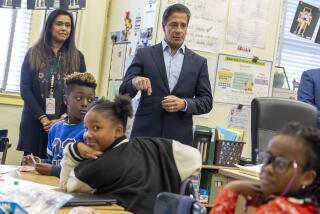Longer School Year Put on Hold : Education: Oxnard board delays taking action on proposal to add 20 days of instruction after teachers and students raise concerns.
OXNARD — Faced with growing hostility from teachers, Oxnard Union High School District officials decided Thursday to delay going forward with a proposal to extend the school year by 20 days.
*
The board voted 4 to 0 to wait until Dec. 6 to make a decision on a $15,000 contract that would pay for two consultants to help district officials write and usher a bill through the state Legislature to seek $9 million over three years to pay for the longer school year. Trustee Steve Stocks was on vacation.
After hearing seven teachers and a handful of students raise concerns about the proposal, Trustee Nancy Koch said she wanted more data on the possible benefits of a 200-day school before she would approve the expenditure.
“We’re sticking our necks out there,” Koch said. “I’m not against this . . . but I need more information.”
Darrell Larkin, president of the 450-member Oxnard Federation of Teachers, said instructors are uncomfortable supporting the longer school year because district officials have told them so little about it.
“There is a lot of apprehension at the different sites about this proposal,” Larkin said. “Please involve the staffs with this project. Let us be heard.”
Other teachers said they are worried that parents and students will reject the new schedule before it ever gets off the ground.
An earlier proposal to convert Oxnard High School to a year-round calendar failed because the community did not support it, said Oxnard High School teacher Arthur Garduna. That change had been suggested in 1993, also as a way to improve student achievement, he noted.
“We need to find out how the community feels first, before we go to the state,” he said.
Ken Hall, a consultant with Sacramento-based School Services of California, agreed that the board should delay action until district officials have been able to consolidate more support.
“Give yourself a month to evaluate this,” Hall said. “We won’t get very far in the legislative process anyway if you have the insecurity with this proposal that I see here tonight.”
*
But Hall also warned that the longer the district waits, the less likely legislators will be willing to shake loose dollars for the proposed three-year pilot project. District officials estimated the cost of extending the school year at $3 million a year, nearly all of which would go to pay teachers for working added days.
The district is in a prime position to win legislative support for the project now because the state economy is growing and money for innovative education reforms are available for the first time in five years, Hall said.
“Other projects will consume available education dollars,” he said. “You miss the growth curve by waiting.”
Supt. Bill Studt has proposed adding 20 days to the current 180-day school year as a way to boost student grades in the 12,800-student high school district.
It is a measure that is talked about in the education Establishment as a way to boost flagging student achievement in this nation. Other countries, such as Japan and Germany, require students to attend school for 240 days a year.
U.S. Education Secretary Richard Riley has said other education reforms instituted in the past decade are destined to founder “unless they are harnessed to [provide] more time for learning.”
But little has been done to implement longer school years elsewhere in the nation because of strong opposition from parents, students and teachers. The national average is 180 days of instruction.
Research shows that students learn better when they have more time to spend on a subject, said Gary Davis, the district’s assistant superintendent of educational services. And students are being asked to learn more now than ever before, he said.
*
For instance, pupils must take a computer literacy class before they can graduate, he said. They also must undergo career skills training, study skills courses and a flurry of testing that was unheard of a generation ago, Davis said.
Studt disputed Larkin’s contention that teachers were not told about the proposal until a few days ago. He said he spoke to leaders of the unions for the teachers and support staff more than two weeks ago.
“This hasn’t been a secret,” he said. “We have been out there discussing this with a lot of people.”
Board President Jean Daily-Underwood said she strongly supports Studt’s proposal and urged her fellow board members to take a stand with him.
“Are we risk-takers or not?” Daily-Underwood said, drawing hisses from many of the teachers in the audience.
A 16-year-old Camarillo High School junior who identified herself as Veronica told the trustees that she would rather see the money used to buy new books and build more classrooms at her overcrowded school.
“I’d rather see the money used to improve our present learning conditions,” she said.
More to Read
Sign up for Essential California
The most important California stories and recommendations in your inbox every morning.
You may occasionally receive promotional content from the Los Angeles Times.











